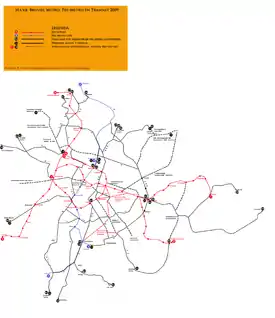Trams in Brussels
The Brussels tram (or streetcar) system is a transport system in Brussels, Belgium. It is the 16th largest tram system in the world by route length, in 2017 providing 149.1 million journeys (up 9.5% on 2016) over routes 140.6 km in length.[1] In 2018, the Brussels tram system consisted of 18 tram lines (eight of which – lines 3, 4, 7, 25, 32, 51, 55 and 82 – qualified as pre metro lines, and five of which - lines 3, 4, 7, 8 and 9 - qualified as "Chrono" or "Fast" lines). Its development has demonstrated many of the quandaries that face local public transport planners. The Brussels tram system also has several interesting peculiarities: the inconsistent route pattern resulting from the closure of the interurban trams, the conflict between low-floor surface trams and high-floor underground trams, and whether the trams run on the right or the left.
| Brussels tramway network | |||||||||
|---|---|---|---|---|---|---|---|---|---|
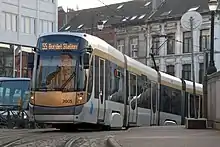 A Bombardier T3000 in Brussels, 2010 | |||||||||
| Operation | |||||||||
| Locale | Brussels, Belgium | ||||||||
| Routes | 18 (2019) | ||||||||
| Owner(s) | Brussels-Capital Region | ||||||||
| Operator(s) | STIB/MIVB | ||||||||
| Infrastructure | |||||||||
| Track gauge | 1,435 mm (4 ft 8 1⁄2 in) standard gauge | ||||||||
| Propulsion system(s) | Electricity | ||||||||
| Electrification | 600 V DC overhead lines | ||||||||
| Depot(s) | 7 | ||||||||
| Stock | 397 | ||||||||
| Statistics | |||||||||
| Track length (total) | 140.6 km | ||||||||
| Route length | 141.1 km (87.7 mi) | ||||||||
| 2017 | 149.1 million | ||||||||
| |||||||||
| |||||||||
| |||||||||
| |||||||||
| |||||||||
| Website | STIB/MIVB (in English) | ||||||||
History
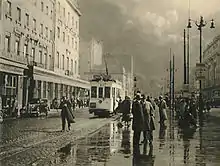
Before the First World War
Belgium's first horse-drawn trams were introduced in Brussels in 1869, running from the Porte de Namur to the Bois de la Cambre.[2]
In 1877 a steam tram was introduced but it was not powerful enough for the hilly terrain and the tests were stopped. Simultaneously the Tramways Bruxellois experimented with a locomotive built in Tubize but it did not work either. The components proved too fragile and this experiment was also discontinued. In 1887 experiments were made with accumulator trams, but these had a very limited range. Trolley power, used in Liège, was also tried in Brussels and in 1894 Brussels's first electric tram lines were laid from Place Stéphanie/Stefanieplein to Uccle/Ukkel. Several companies built their own tram lines until the turn of the century, the most important being:
- TB: Les Tramways Bruxellois: founded on 23 December 1874 on the merger of the Belgian Street Railways and Omnibus Company Limited led by Albert Vaucamp and the Société des Voies ferrées Belges led by William Morris (Morris & Sheldon Company). The TB started with five horse tramlines:
- Schaerbeek - Room Forest (Morris)
- Uccle – Place Stephanie (Morris)
- Liedtsplaats - Sint-Gilles (Vaucamp)
- Laeken - South (Vaucamp)
- Laeken - Anderlecht (Vaucamp)
- CFE: Les Chemins General de Fer Economiques’: known before 1880 as Compagnie Générale de Tramways. The CFE electrified its lines from 1904 onwards. These lines had the Stock Exchange as the central hub.
In addition, there were smaller companies:
- Tramways de Bruxelles à Evere et Extensions: founded in 1883
- Chemin de Fer à Voie Etroite de Bruxelles in Ixelles-Boondael: founded in 1884, and taken over by the TB on 28 April 1899.
These last two companies used metre-gauge track and started with steam traction instead of with horse trams. In 1899, the TB was granted a 45-year concession on condition that the whole network was electrified, a condition that was met in the following years. Until the First World War, many investments were made in the network, such as heavier rails and more powerful trams. The vicinal/buurtspoor networks set up city services.
After the First World War
Tram services were not restored to normality until 1925. During the war there was poor maintenance, many horses were requisitioned and tram equipment was used for military purposes. On 1 January 1928, the TB and CFE networks merged, leaving only the TB and the vicinal/buurtspoor network in operation. The CFE was known for its 'chocolate bars' so named because of their dark brown livery (several examples can still be admired in the Brussels tram museum). CFE personnel also wore brown uniforms. In 1928 the CFE lines were renumbered within the TB system. In 1935, the Brussels tram network was 240 kilometres long, making it one of the larger tram networks in Europe. There were almost 100 tram lines, including many direct connections between the various boroughs. For the World Exhibition of 1935, the famous '5000-series' trams, the first in Brussels with two bogies, were put into service.
Because the TB concession expired on 31 December 1945, an agreement was concluded between the State and the Province of Brabant to continue the operation of the Brussels trams. A provisional management committee was set up, which functioned until the foundation, on 1 January 1954, of the Société des Transports Intercommunale de Bruxelles/Maatschappij voor de Intercommunaal Vervoer in Brussel (STIB/MIVB). Great efforts were made to catch up on overdue maintenance and 787 motor trams were modernised to the Brussels standard type. The electro-pneumatic brake was introduced in these cars and the conductor and driver (called Wattman in Belgium) had permanent seats.
Growing traffic congestion led to plans to build reserved tracks for trams, and in the city centre to put them in tunnel. In 1957, the first tunnel was opened near the congested Constitution Square, between the South Station and Lemonnier. From 1969, trams were adapted to run in tunnel, using block signalling.
In addition to the major refurbishment of the standard cars, STIB/MIVB had a great need for modern equipment to serve the World Exhibition in 1958 (Expo 58), to which its organisers wished to provide public transport access from all the city. To this end, large turning loops for hundreds of trams were laid out in the exhibition grounds. Between 1951 and 1953, the PCC car entered Brussels with motor car 7001, the start of a series of 172 cars. Over the years, many series of single-ended versions (7500 and 7700 series, 128 car) and double-ended versions (7900 series, 61 cars) followed. Eventually, the PCC car entirely replaced motor wagon and trailer combinations.
The development of the premetro, a tram-unfriendly policy and a constant shortage of funds led to a deterioration of the Brussels tram system well into the 1990s, with many routes being replaced by metro lines or converted to bus routes. Only with investment in new equipment (the T2000 tram) and the upgrading and improvement of the tram network did the balance turn positive.
Intermodal integration
The system exists in a somewhat unusual local government context, because Brussels is a self-governing region, as an enclave within Flanders, although only some 3.3 kilometres from Wallonia at the closest point. This means that three-way deals are necessary between Brussels’ own STIB/MIVB, Flanders’ De Lijn and Wallonia's TEC.
STIB sees itself as a provider of mobility rather than just public transport, and has a 49% share in the Cambio[3] carsharing franchise. The Brussels conurbation — 19 municipalities plus adjoining commuter belt — is also served by a fairly dense network of main-line trains. The MOBIB contactless smart card can be used on buses, trams, the metro and for mainline railway season tickets, and is gradually being extended to other modes, although it is not yet accepted for single journeys by De Lijn. A simple tariff system permits unlimited changes with a one-hour period for €2.50 when bought from the driver, €2.10 from a ticket machine. Real-time arrival indicators have been installed at many tram stops.
Ridership has been rising, and user-friendly features that have grown up through custom and practice help this. For instance, passengers open the doors by pressing a green strip on the central pole (in PCC trams) or an illuminated button (on Flexity trams), and drivers usually make a point of waiting for latecomers. However, overcrowding at rush hours and at weekend is common. The rate of detected fare-dodging is 4.15%,[4] despite periodic enforcement campaigns, and this is being addressed by the installation of ticket barriers in all metro stations. From 2013, the obligation to check out of as well as into the system is being progressively introduced.
Routes
Development of the network
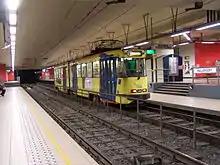

As of 2017, there are 17 tram routes,[5] totalling 141.1 kilometres (87.7 mi),[4] and serving most parts of the city, including three partial ring routes (7, 8, and 81). The routes have a very varied feel, including street running through narrow streets in working-class districts (line 81), cobbled central reservation, reserved track through parkland and woods (line 44), signal-controlled running in tunnels (the premetro lines 3 and 4 in the North–South Axis, and 7), and short stretches in cutting (the old route 18, closed in 2007). Almost all trams are double-ended and all are double-sided, and while some stub termini remain (4, 51, 97), most have loops. The route pattern shows some notable gaps, particularly along major radial routes, because these were originally served by the national network of buurtspoorwegen/tramways vicinaux. These had a gauge of one metre, rather than the Brussels standard gauge, and so the tracks could not easily be taken over when the lines were progressively closed from the 1960s onwards.
The complementary routing of vicinal and urban tracks and the replacement of key lines by metro has led to some peculiar track layouts, for instance at the Barrière de St-Gilles/Bareel St-Gillis. Though all seven roads at this circular junction originally had tram lines, only three of the original seven remain.[6] To negotiate a sharp turn, the old route T18 (closed 1 July 2007) had to make a 270-degree turn on its journey away from the city centre, looping round and crossing its own path.
Under the South station, the premetro and metro tracks swap from running on the right to running on the left where they run parallel to provide cross-platform interchange between the two lines. This serves no apparent purpose, but may be because main line trains in Belgium run on the left. Trams cross back to the right under Place Bara but the metro stays on the left as far as the Roi Baudouin terminus.
By 2016, Bruxelles Mobilité/Brussel Mobiliteit had installed traffic light priority for trams or buses at 150 junctions.[7] In some other places, the track layout is used to avoid hold-ups; for instance on route 92 at the Ma Campagne and Place Janson crossroads, which lie 300 metres from each other on the Chaussée de Charleroi/Charleroisesteenweg. There is lateral space for only one track in a raised central reservation, and the rails swerve to the left approximately 100 metres in front of the junction so that cars can queue in the right-hand lane.
Between 2006 and 2009, a phased transformation of the network took place, with the aim of improving regularity and relieving overcrowding. The premetro service between North station and Albert was restructured with fewer lines passing through it, but at more regular intervals. These routes use the new longer Bombardier trams. The major part of the North-South Axis (from Lemonnier to Rogier) is now used only by lines 3 and 4 during the day, branded Chrono. Tram line 55 from Schaerbeek (north of Brussels) that used to use the North-South Axis now terminates at Rogier. The old line 52 was replaced by line 3 in the north (from Brussels-South railway station to Thomas and from Van Praet to Esplanade), 82 (from Drogenbos to Lemonnier) and 32 in the south. The old tram line 56 was also withdrawn.
A previously implemented part of the plan was the creation of line 25 in April 2007. Line 25 goes from Rogier to the Boondael/Boondaal railway station following the route of the former line 90 from Rogier to Buyl, then leaves the outer ring towards the Université Libre de Bruxelles campus of Solbosch.
On March 14, 2011, old lines 23 and 24 were merged to create the new eastern semicircular premetro line 7 which runs almost entirely in its own right of way from Heizel/Heysel in the north to Vanderkindere in the south.
Current routes
Tram routes as of November 2019:[8]
- 3: Esplanade — Churchill
- 4: Gare du Nord / Noordstation — Stalle Parking
- 7: Heysel / Heizel — Vanderkindere
- 8: Louise / Louiza — Roodebeek
- 9: Simonis — Arbre Ballon / Dikke Beuk
- 19: De Wand — Groot-Bijgaarden
- 25: Rogier — Boondael railway station
- 32: Da Vinci — Drogenbos Château / Drogenbos Kasteel Only in the evening.
- 39: Montgomery — Ban Eik
- 44: Montgomery — Tervuren Station
- 51: Stade / Stadion — Van Haelen
- 55: Da Vinci — Rogier
- 62: Eurocontrol — Cimetière de Jette / Kerkhof van Jette
- 81: Marius Renard — Montgomery
- 82: Berchem Station — Drogenbos Château / Drogenbos Kasteel
- 92: Schaerbeek Gare / Schaarbeek Station — Fort Jaco
- 93: Stade / Stadion — Legrand
- 97: Louise / Louiza — Dieweg
Stricken-out numbers represent partial services (they do not go up to the end of the line). Only regular services are shown in this list.
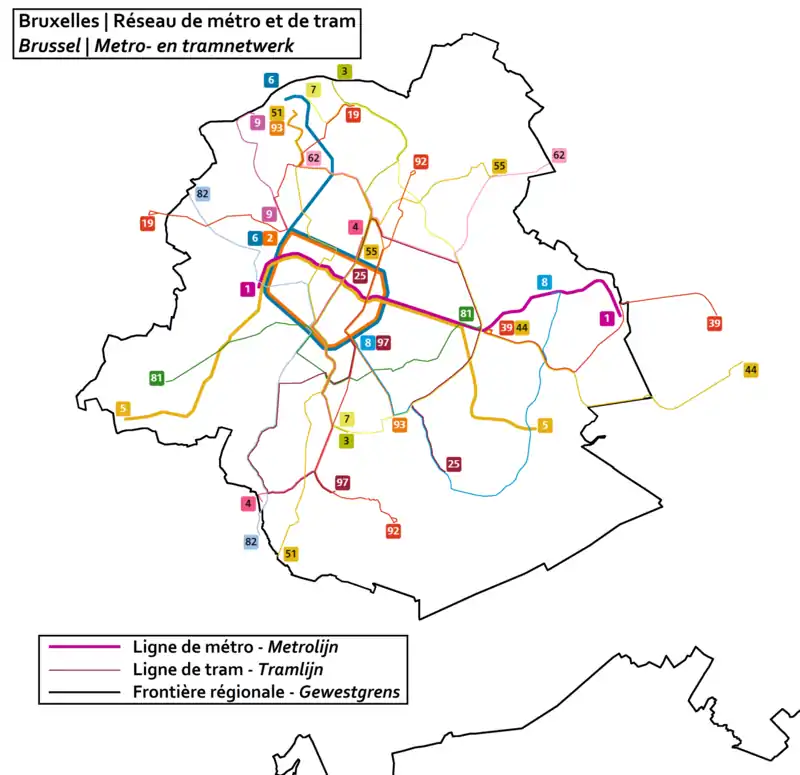
Planned extensions
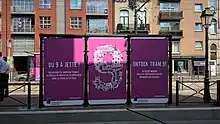
In the 21st-century political climate, investment in light rail has again taken off, and a number of extensions to the system are at various stages of fruition.
Lines 3, 7 and 9 are to be connected at the Heysel/Heizel, and on 20 December 2018, Brussels Mobility Minister Pascale Smet announced[9] that the next two lines to be built, estimated to open in 2024, will run:
- from Place Rogier/Rogierplein to Belgica via Nord/Noord and Tour et Taxis/Thurn en Taxis (seat of the Flemish regional government)
- from Place Rogier/Rogierplein to Hôpital Militaire/Militaire Ziekenhuis in Neder-Over-Heembeek via Van Praet
The Flemish region, under its Brabantnet plan, intends to build a new line to the north of the city, from Heysel/Heizel to Willebroek alongside the A12 road.[10] Its success will require integration with the existing Brussels regional system; for instance the line will have to be built at standard rather than metre gauge (as the other Flemish trams are).
Three other suburban/interurban lines had been proposed:
- from Brussels westwards to Ninove
- from Brussels north-eastwards to Heist-op-den-Berg
- from Heizel/Heysel via Vilvoorde to Zaventem airport
The first two proposals were withdrawn, while the last has been implemented in 2020 as a 'tram-bus'.[11] The Ringtrambus (route 820) from Brussels Airport to Jette opened on 28 June 2020, operated by 14 24-metre double-articulated buses. The initial half-hourly frequency was doubled to quarter-hourly on 1 September 2020.[12][13]
Other proposals have been aborted. During 2014 and 2015 STIB/MIVB promoted a project to 'tramify' the Porte de Namur/Naamsepoort to Delta section of the overloaded 71 bus route, which carries over 12,000 passengers per day in each direction.[14] The Brussels region supported the proposal, but the municipality of Ixelles/Elsene was against, supported by traders on the Chaussée dÍxelles/Elsensesteenweg who feared the disruption the tracklaying would cause. The proposal was dropped and instead the section from the Chaussée de Wavre/Waversesteenweg to Place Fernand Coq/Fernand Coqplein has been made largely car-free.[15]
Other outline proposals have been made to:
- extend the 62 to Zaventem airport (with the infrastructure being paid for by the Flemish Region)
- divert the 92 from Rue Royale/Koningsstraat to serve Central Station
- rebuild the east–west link through the city centre from Bourse/Beurs to Place Royale/Koningsplein
On 18 July 2019 the Brussels government, in its programme for the period 2019–2024,[16] committed itself to set the following additional developments in train:[17]
- conversion of bus route 95 from Central Station to the university area (partially making up for the failed conversion of route 71)
- extension of route 25 eastwards to serve the Mediapark
- extension of route 7 westwards to Forest (this may include a tunnel under the Parc de Forest/Park van Vorst from Albert, where lines 4, 7 and 51 will terminate when the heavy metro is extended to Albert) and conversion of bus route 49 to form a western ring line
- extension of route 8 northwards to Evere and eastwards to Jesus-Eik
Track maintenance
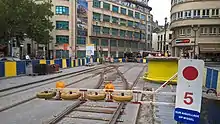
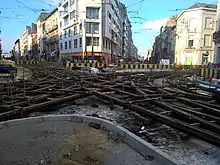
Track is renewed periodically, both when it wears out, and also to increase the lateral clearance between tracks, to enable the safe passage of wider trams. Minor imperfections are smoothed by in-situ welding. When a temporary diversion is required, STIB/MIVB often installs a set of temporary or 'Californian' points which sits on top of the permanent rails.
Track has historically been embedded in stone setts, with STIB/MTUB taking responsibility for the road up to 30 cm on either side of the rails. However recently tarmac has been used, which improves conditions for cyclists.
In recent years when major junctions have been relaid, the opportunuity has been taken to increase stability by installing a concrete raft underneath the whole junction.
Signalling
On the overground parts of the network trams drive at sight, while the underground premetro sections have block signalling. However drivers do not need to check in and out of the signalled section as on the Muni system in San Francisco. An exception is in the earliest tunnel to be built, at the Lemonnier stop, where passengers cross the tracks using an underground level crossing. This station will be bypassed when the line is converted to heavy metro and the new Toots Thielemans station built slightly to its east.
Vehicles
Fleet
As of 18 September 2017, the fleet consists of 396 trams, of the following types:[18]
- 64 7700-series 2-section PCCs (20m)
- 61 7900-series 3-section PCCs (27m)
- 51 2000-series 3-section purpose-built Bombardier T2000s
- 150 3000-series 5-section Flexity Outlook Cityrunners (30m)
- 70 4000-series 7-section Flexities (41m)
As of 18 June 2019, 90 new sets of Flexities are on order.[19]
High-floor and low-floor
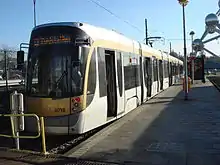
The development of the system is being pulled in two contradictory directions – towards low-floor street-running trams and high-floor underground railway. This has led to some conflicting decisions. The standard trams — still "PCC's from the 1950s and 60s — have been followed by the specially designed "T2000" low-floor model and, at the end of 2005, by a variant of the off-the-shelf "Flexity Outlook" from Bombardier (3000 series), and, at the end of 2006, by an even longer version of the same family (4000 series).
On some of the busiest routes, the convenience of the low floor is lost because of the anomalies caused by the hesitant upgrade of tram to metro. The city has four heavy metro lines and three stretches of premetro or underground tram. The premetro tunnels have been built to allow for eventual upgrade to heavy metro, so most of the platform is high, and is connected to the street (at least in the upward direction) by escalator. At some stations lifts have been installed, but there is a cutout section taking the level down to one foot above ground to board the trams. The three steps this entails make life difficult for passengers with baby buggies or suitcases, even though the new low-floor trams are accessible to wheel-chair users. To get around this last barrier to mobility, an experimental ramp was installed in 2009 at Parvis de St-Gilles/St-Gillis Voorplein.
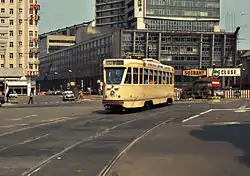
Coupled sets
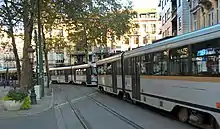
Coupled sets are not currently used, although since c. 2015 tests have been made of pairs of PCCs connected by a towbar. All vehicles still carry a towbar, which is only used nowadays when a broken-down tram needs to be towed or pushed to the depot.
Livery
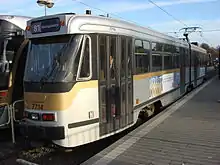
Brussels trams have known several liveries. In the beginning of the 20th century, those operated by the Tramways Bruxellois were dark green, and those by the Chemins de Fer Economiques were chocolate. The two companies merged in the 1920s, whereupon a standard livery of primrose yellow was adopted which lasted (with some minor changes in the trimmings) until the mid-1990s when a brighter shade of yellow was adopted.
A profound change in livery came in 2006 with the adoption of the so-called art nouveau livery of silver and light brown on the new 3000 and 4000 vehicles. The rest of the active fleet has been repainted.
Heritage trams
The system exists in happy symbiosis with an active heritage operation based at Woluwe depot, and privately hired trams have free access to the tracks. Trams that still collect their current through trolley poles rather than pantographs are normally restricted to the scenic line from Cinquantenaire park via Woluwe to Tervuren, which is run with the help of volunteers from the preservation society MTUB (Museum of Brussels Urban Transport), whose board has a strong representation from STIB/MIVB. This runs at weekends from April to October; occasionally, such as on the Belgian national holiday, 21 July, these trams appear in the city centre, where the line in the Koningsstraat/Rue Royale is trolleypole-enabled.
Several trams have been sent to the United States. Tram 7037 is in San Francisco operating on the F-Line, surreally repainted in the blue-and-white livery of Zürich. Tram 1504 is at the Trolley Museum of New York and 1511 is at Old Pueblo Trolley. A 4-axle PCC is also awaiting restoration at the Ontario St shed of Vancouver's Downtown Historic Railway.
Special-purpose trams
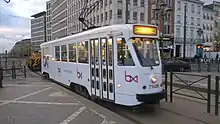
One PCC tram was converted in 2012 into a mobile restaurant, which operates six evenings per week.[20] Its fleet number is 7601,[21] formerly 7765 and before that 7565.
A second PCC tram, 7126,[22] serves as a mobile studio for the Le Tram television programme broadcast by BX1 (formerly Télé Bruxelles) every other Sunday, during which an interview is conducted while the tram tours Brussels.[23] The tram tows a generator trailer.
2010 Vancouver Olympics
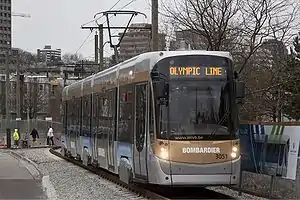
From January 21 to March 21, 2010, a demonstration streetcar project, known as the Olympic Line, at Vancouver, British Columbia, Canada, used cars 3050 & 3051 (Bombardier Flexity Outlook) on a Vancouver Downtown Historic Railway 1.8 km track.[24]
Depots
STIB/MIVB has 7 depots and maintenance facilities:
- Avenue du Roi/Koningslaan (Saint-Gilles/Sint-Gillis) - 63 trams
- Rue d’Enghien/Edingenstraat (Molenbeek) - 39 trams
- Houtweg (Haren) - a major bus, tram and metro reception and repair facility - 87 trams
- Avenue de l’Hippodrome/Rennbaanlaan (Ixelles/Elsene) - 98 trams
- Chaussée de Haecht/Haachtsesteenweg (Schaerbeek/Schaarbeek) - 40 trams
- Woluwe - on the site of the Brussels Tram Museum - 35 trams
- Marconi (Forest/Vorst) - the newest depot, fully opened in 2017 - 34 trams
Statistics
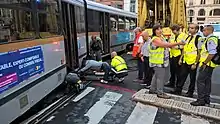
Most of these statistics come from STIB/MIVB's 2018 activity report,[25] though some are from previous reports.
- Passenger journeys (2018): 165.5 million
- Length of tram line (double-track, 2018): 147.1 km (91.4 mi), of which 85.6 km (53.2 mi) (60%) are in dedicated lanes (i.e. own right-of-way) and 12.4 km (7.7 mi) (9%) of which are in tunnel
- Average distance between stops: 411 metres (2018)
- Vehicle-kilometres travelled (2018): 15.3 million
- Seat-kilometres travelled (2018): 2,932 million
- Commercial speed (2017) 15.9 km/hr
- Share of passengers holding a season-ticket (2017): 87%
- No of trams (2017): 397 (2017)
- Peak run-out (winter 2017): 301[26]
- No. of depots: 7, with 2 workshops (2018)
- No. of points: c. 850 including those in depots[27]
References
| Wikimedia Commons has media related to Trams in Brussels. |
- Tramways and Urban Transit, July 2005, published by the Light Rail Transit Association. ISSN 1460-8324
- (in French) Tram2000 – a monthly magazine
Footnotes
- http://www.stib-mivb.be/irj/go/km/docs/WEBSITE_RES/Attachments/Corporate/Statistiques/2017/STIB_RA2017_Statistiques_FR_HDok.pdf
- "STIB - La STIB de 1890 à 1953" [STIB - STIB from 1869 to 1953] (in French). STIB. 2013. Archived from the original on 2013-12-21. Retrieved 2013-09-15.
- Cambio
- http://2016.stib-activityreports.brussels/en
- "STIB - Timetables and real time". STIB/MIVB. 2013. Retrieved 2013-09-15.
- Map from September 1949 by J.C. Gillham inside back cover of Brussels - A Tramway Reborn 1945-2008, Geoffrey Skelsey & Yves-Laurent Hansart, Light Rail Transit Association, Peterborough UK, 2008, ISBN 978-0-948106-36-1
- https://brussels.revues.org/1377?lang=en
- "www.stib-mivb.be". www.stib-mivb.be. Retrieved 2020-01-18.
- https://www.lalibre.be/regions/bruxelles/deux-nouvelles-lignes-de-tram-prochainement-a-bruxelles-5c1cb46ecd70fdc91c18ea04
- http://www.bruzz.be/nl/nieuws/groen-licht-voor-trams-naar-luchthaven-en-willebroek
- https://www.delijn.be/nl/mobiliteitsvisie2020/brabantnet/wat-is-brabantnet/jette-airport.html
- https://www.delijn.be/nl/overdelijn/nieuws/bericht/24746_de_lijn_zet_vanaf_28_juni_ringtrambus_in_in_vlaamse_rand
- https://www.delijn.be/nl/lijnen/lijn/3/800/2/820_Jette_-_Vilvoorde_-_Zaventem#dienstregeling
- https://www.thebulletin.be/tram-71-plan-scrapped-brussels-unveils-new-transport-map
- http://www.bruxellesespacespublics.irisnet.be/places-et-voiries/chaussee-dixelles-reamenagement-de-lespace-public/
- http://www.parlement.brussels/wp-content/uploads/2019/07/07-20-D%C3%A9claration-gouvernementale-parlement-bruxellois-2019.pdf Déclaration de politique générale commune au Gouvernement de la Région de Bruxelles-Capitale et au Collège réuni de la Commission communautaire commune. Législature 2019-2024, pp. 75-76
- Tram 2000 August 2019, p. 38
- Tram 2000 November 2017, p. 10
- Bombardier to supply 30 more next-generation Flexity trams to Brussels, accessed 2019-07-16.
- https://visit.brussels/en/sites/tramexperience/
- "Nightfall on the tram restaurant at Louise, Brussels, Belgium". www.lesrails.com. 2013-10-20. Retrieved 2017-08-12.
- "Tram 7126, mobile TV studio in Brussels, Belgium". www.lesrails.com. 2016-01-31. Retrieved 2017-08-12.
- http://bx1.be/emissions/le-tram/
- http://2018.stib-activityreports.brussels/file/statistics_2018_fr.pdf
- Tramways and Urban Transit, January 2018
- An van Hamme of STIB/MIVB, Bruzz, 2 February 2017 http://www.bruzz.be/nl/video/jouw-vraag-waarom-moeten-tramconducteurs-nog-vaak-uitstappen-om-wissels-te-veranderen
External links
- Official English site
- Official English system map
- Brussels Studies 7: The direct cost and geography of Brussels mass transport’s operating delays, Frédéric Dobruszkes & Yves Fourneau, 24 May 2007
- Brussels Studies 20: The (in)efficiency of trams and buses in Brussels: a fine geographical analysis, Xavier Courtois & Frédéric Dobruszkes, 27 June 2008
